President's Message
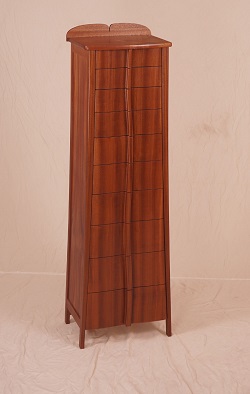
Peoples Choice
BAWA Show 2016

Best of Show
BAWA Show 2016
Fellow woodworkers,
Once more it is the year for our Biennial Fine Woodworking Show. This year we will be holding it in May to make it easier for students doing woodworking at the various schools in the Bay Area to participate.
Previously we have held it at the end of October, but as most school classes start in September students do not have projects finished in time for our show. So this year, by choosing May, which is near the end of term, we hope to make it easier for students to exhibit
Once again Eric and his staff at Woodcraft have been kind enough to invite us to have the show in their showroom on El Camino, San Carlos.
Opening Reception is Friday 18th May: 6.00pm to 8.00pm
Show opening hours are Saturday 19th May: 10.00am to 5.00pm
Sunday 20th May: 11.00am to 5.00pm
We have one, not very challenging goal, we would like to achieve this year:- Early notification of your plan to exhibit at the show!
Every year we end up with a great selection of entries from our members and guests - but it never seems like it is going to be that way; most entry forms are sent in on the last week before the show. It makes it hard for the organizers to plan how to arrange the exhibits etc. - plus the hoping and waiting is a little bit stressful for them. Entering earlier makes it so much easier. So please can you start thinking about what you may want to exhibit and go to the on-line Entry Form and submit it to us
Closing day for entries is Monday 14th, May.
See our Show Page for entry details and form: BAWA_Show_Entry2018.html
For some inspiration of what to show you can check out some of our previous shows:
Mike Tracy is Chairman of this year's show; he is looking for volunteers to help with organising and running the show, contacting high schools and vendors, etc., plus any ideas you have to make the show better. He would love to hear from you.
You can contact Mike at: md_trac@yahoo.com
We have printed postcards and posters to advertise the show that are available to members to distribute. Contact me if you would like some.
Enjoy your woodwork
Frank (Contact at: Frankramsay8@aol.com)
The meeting was called to order by President Frank Ramsay at 6:10 PM.
New Members and Guests
Responding as guests or new members were Keith Miller, who has made tables and sculptures, Tom Quan who has built furniture, Dimitri Podarkis, who builds cabinets and furniture, and Arthur, who is doing a school project.
Announcements:
Next month our speaker will be Scott Wynn who will discuss metal work for woodworking projects.
The BAWA Woodworking Show will take place on May 18-20.
John Blackmore announced that some of Arnie Champagne's remaining items, including wood and some prototype parts in Doug Fir for a Maloof rocker, are still available for sale. There are also a few miscellaneous plane parts available for free.
For silent auction we have a detail sander, a drill bit sharpener, and 2 pair of Blum slides.
Featured Speaker: Mark Tindley
"Building Tables in the Greene and Greene Style"
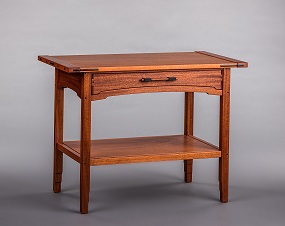
Our main speaker, Mark Tindley was introduced by Frank and his talk covered the design and construction of Greene and Greene style furniture. The Greene brothers, Charles and Henry, were architects who mostly designed complete houses, including furniture, in the early 20th century, primarily in California. They set up an office in Pasadena from 1902-1910. Mark illustrated the design characteristics of the Greenes' style with a plant stand…square pegs, cutouts on the lower shelf, swirling grain, rounded edges, and cloud lifts. Mark showed examples of other pieces from the Thorsen house in Berkeley and the Gamble House in Pasadena. The square pegs were mostly purely decorative and had no structural function. The pegs were made of dark ebony, which contrasted well with the mahogany used in the furniture. The Hall brothers, Peter and John, did the actual woodworking.
Mark then went on to describe the detailed process for the construction of a Honduras mahogany table that he designed using SketchUp. It uses ebony splines and square pegs, curved cloud lifts, and waterfall tapered legs. The shape is based on the golden rectangle dimensions.
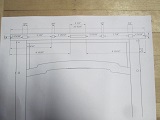
SketchUp plan.
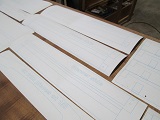
SketchUp prints laid out on board.
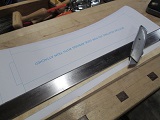
Marking out cuts.
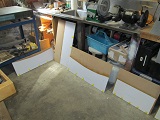
Plan sheets stuck onto template.
After completion of the SketchUp design, Mark prints out full size templates, which he glues to super refined MDF using type 1 Titebond. After carefully marking all defects with a charcoal white pencil, he lays out each template piece on the raw stock and rough cuts the pieces using the band saw. The pencil shows up well on dark wood and can be easily erased.

Bandsawing template to approximate size.
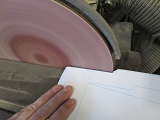
Using sanding disc to help shape template.
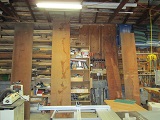
Lumber lined up for selection.
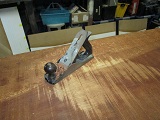
Checking colour and grain of lumber.
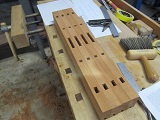
Legs after tenons cut.
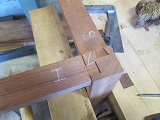
Top rails dovetailed into legs.
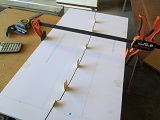
Checking gap on templates for front drawer and rails.

Shaping ends of dummy Ebony pegs
When installing the square plugs, he taps them into place using a mask of the proper thickness to assure that he doesn't drive them in too deep.
The legs were glued together out of book-matched pieces so the joint disappears.
The legs were all clamped up at the same time using wax and packing tape to make sure that the wrong things did not stick together. The tenons were all rough-cut on the band saw and hand finished with handsaw and chisel, paring in small steps. The drawers have both side runners and a bottom runner. The location of the bottom runner in the middle of the drawer is determined by using templates cut to the correct length rather than using a ruler to measure. The curved pieces were all cut using the bandsaw first and then refined using a router template bit. On the final glue-up it is best to subdivide the process into as many steps as possible to avoid having to do too many things while the glue is setting up. It is important to use a story stick to test the diagonals for squareness at the last step and apply diagonal clamping pressure on the longest diagonal to correct any errors. After rough cutting the drawer frames they are refined to final dimensions using hand planes. The drawer bottoms are made from bandsawn mahogany veneers, 1/16" thick, glued to ¼" thick MDF using a vacuum press pumped by a Venturi pump.The square pegs were formed by chucking them into a hand drill and polishing them up to 2000 grit backed by a soft sponge to create a rounded top. The handles were formed from dowels made by running a metal die cutter over roughly formed stock and then sanding off the threads. Mark demonstrated this very quick procedure for us. After sanding the project to 150 grit, 3 coats of Osmo Polyx finish are added, which is applied like Danish oil and then wiped dry. It is waterproof.
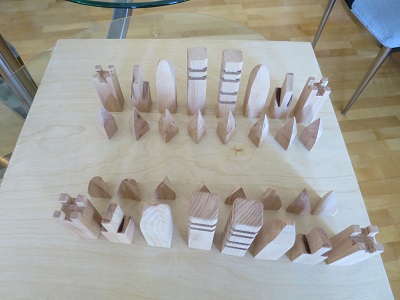
After the break Frank Ramsay described a commission for an abstract chess set design that an artist is going to paint.

Burt Rosenzweig showed a balsa model airplane he had built.

Jon Kaplan showed a mystery project which turned out to be another in the continuing BAWA saga of toilet paper holders started by John Blackmore.
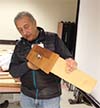
Finally, Steve Rosenblum asked for refinishing advice for a bathroom cabinet drawer in which the finish had degraded in a few spots. Mohawk retouching pens were suggested.
Stephen Rosenblum, Secretary steve@rosenblums.us
